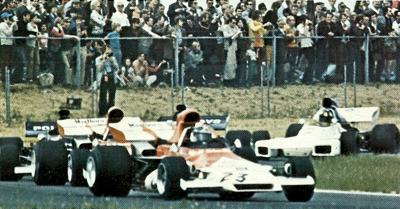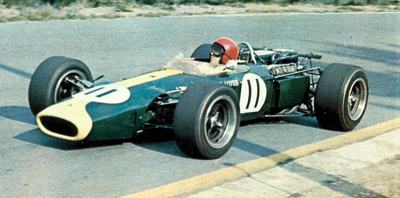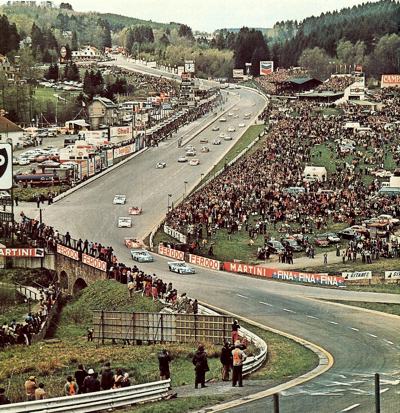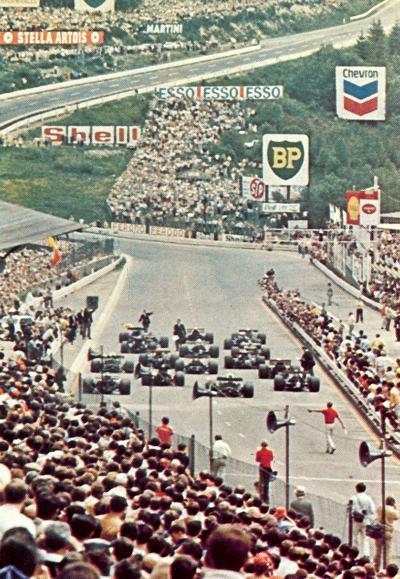SPA-Francorchamps
The Francorchamps circuit was conceived by Jules de Thier, from SPA. A motor racing enthusiast, de Thier evolved a triangular 9.24-mile course using public roads set in a valley and lined by a dense pine forest, farm cottages and fields. From the start, shortly after a sharp hairpin bend at La Source near the village of Francorchamps (which itself is five miles from the town of SPA), the road plunged downhill, went left to the Old Frontier hairpin (before World War 1 this was the German/Belgian border) and then climbed up and over a wooded crest. Then the trees stopped, the road twisted left, right and then ventured towards Burnenville, a fast right-hander bordered by farm-buildings.
Malmedy and Stavelot
Malmedy in its early days was a right-angle bend which led to the Masta Straight, a 'straight' of almost two miles, past farms and through Masta village with its notorious, flat-out kink. Then came Stavelot, originally a hairpin bend, and the road began to rise again, twisting and turning through full-throttle curves towards the La Source hairpin and the start/finish line. Resurfacing before World War 2 made the track smoother, but in 1947 the Old Frontier hairpin was removed, being replaced by an uphill sweep at Eau Rouge which reduced circuit length to 9 miles.
More modifications followed: the circuit was widened in places, corners eased slightly. Lap speeds rose. The right-angle turn at Malmedy was replaced by a long sweep, which increased cars' entry speed on to the long Masta Straight, at the end of which a slightly banked sweep replaced the Stavelot hairpin. The inside of La Source was also banked. This reduced the lap distance to 8.77 miles and speeds rose even further. In 1957 more resurfacing and corner-easing, bringing the length down to 8.76 miles, resulted in yet higher speeds. The first race, in 1924, was a 24-hour event for voitures cl chassis catalogues designed to rival the similar race at Le Mans.
Henri Springuel and Becquet
Henri Springuel and Becquet, driving a 2-liter Bignan, covered 1168.2 miles at an average speed of 48.98 mph. Francorchamps' fame spread quickly, for in 1925 the Royal Automobile Club de Belgique was asked to organise the European Grand Prix (also the first Belgian Grand Prix). With the withdrawal of the Sunbeams and Guyots, there were but seven starters, four Delages and three Alfa Romeos. Antonio Ascari led the 502-mile race from start to finish in his Alfa Romeo P2, averaging 74.44 mph. Team-mate Giuseppe Campari was second-22 minutes behind. The 24-hour race was held each year until 1933 and then again in 1938 before war intervened. The Grand Prix was held from 1930--35 and then in 1937 and 1939.
Mercedes-Benz and Auto Union
An incredibly fast race occured in 1937, when the powerful Mercedes-Benz and Auto Union teams ruled Grand Prix racing. Rudolf Hasse, driving a supercharged 6-liter Auto Union C-type, averaged 104.11 mph. Two years later speeds were reduced by heavy rain. Hermann Lang's supercharged 3-liter Mercedes-Benz W163 averaged 94.43 mph, but it was a sad victory.
Dick Seaman, the British driver, was leading when he lost control of his Mercedes at the fast left-hand curve before La Source, crashed into the trees and died of burns received when the car caught alight.
The 24-hour race gained prestige as the years wore on. In 1928 the supercharged If-liter Alfa Romeo crewed by Boris Ivanowski/Attilio Marinoni became the first car to exceed 100 krn/h for the 24 hours, their official average being 102.60km/h (63.75 mph). Apart from 1931, when a massive, supercharged 7.I-liter Mercedes-Benz shared by Prince Djordjadze/Freddy Zehender won, Alfa Romeo dominated the race. Marinoni scored a personal hat-trick by driving the winning car three years in succession, his co-drivers for 1929 and 1930 being Robert Benoist and Pietro Ghersi respectively. Alfa Romeo's 2.3-liter 8C models won in 1932 (Antonio Brivio/Eugenio Siena) and 1933 (Louis ChironLuigi Chinetti), while a 2.9-Iitre sports car set a record average of 77.58 miles per hour in 1938 (Carlo Pintacuda/Francesco Severi).
 Beltoise's BRM P160 leads a group of cars in the 1972 Belgian Grand Prix.
Beltoise's BRM P160 leads a group of cars in the 1972 Belgian Grand Prix.
 SPA Francorchamps was always a great looking circuit. This photo seems to show Peter Arundell admiring the circuit - and who could blame him?
SPA Francorchamps was always a great looking circuit. This photo seems to show Peter Arundell admiring the circuit - and who could blame him?
 Two Matras lead on the opening lap of the SPA 1000 Km race in 1973. The race was won by Derek Bell, and Mike Hailwood's Mirage. Although the circuit featured a great back-drop for the camera's, the "old circuit" always made overtaking extremely dangerous.
Two Matras lead on the opening lap of the SPA 1000 Km race in 1973. The race was won by Derek Bell, and Mike Hailwood's Mirage. Although the circuit featured a great back-drop for the camera's, the "old circuit" always made overtaking extremely dangerous.
 The start of the 1970 Belgian Grand Prix at Spa. The race was won by Pedro Rodriquez in his P153 BRM. By this time, most GP drivers thought the Spa-Francorchamps was too dangerous - and a boycott was not far away.
The start of the 1970 Belgian Grand Prix at Spa. The race was won by Pedro Rodriquez in his P153 BRM. By this time, most GP drivers thought the Spa-Francorchamps was too dangerous - and a boycott was not far away. |
The Death of Freddy Charlier
There was a fatal accident in 1929 when Bugatti driver Freddy Charlier overturned between Masta Village and Stavelot. Francorchamps was back in action in 1947 (now without the Old Frontier hairpin) for the second post-war Belgian Grand Prix. There was an extremely good entry headed by four works Alfa Romeo 158's. Jean Pierre Wimille's Alfa won beating team-mate Achille Varzi against team orders. Carlo Trossi was third after having been relieved for four laps by Alfa manager Battista Guidotti while Trossi was having his nose, which had been cut by a flying stone, bandaged.
St John Horsfall and Leslie Johnson
The 24-hour race was revived briefly in 1948 and 1949. British drivers St John Horsfall and Leslie Johnson took their 2-liter Aston Martins to victory in 1948, although their joy was tempered with the death of British driver Richard Stallebrass at Malmedy, The following year Luigi Chinetti followed-up his Le Mans win with victory in the Francorchamps 24-hours, sharing his 2-liter Ferrari 166 Mille Miglia with Jean Lucas. Fourth overall came Horsfall after a single-handed run in his pre-war Aston Martin.
Fuel consumption decided the 1949 Belgian Grand Prix: Louis Rosier's 4
½ literTalbot-Lago was able to come through to win after a non-stop drive. Into the 1950s the Belgian Grand Prix became firmly established in the World Championship calendar, being cancelled only in 1957 and 1959 owing to financial problems. Alfa Romeos dominated in 1950 and 1951, winners being
Juan Manuel Fangio and
Giuseppe Farina respectively, and it was no surprise when Alberto Ascari's 2-liter Ferrari 500 scooped the honours in 1952 and 1953. It was
Fangio again in 1954 and 1955, with Maserati 250F and Mercedes-Benz W 196 respectively, but the great Argentinian ran into trouble in 1956 and the young British driver Peter Collins (Ferrari D50) won his first-ever Grand Prix.
With the modifications to Stavelot and Malmedy speeds had risen,
Fangio's 1955 average being 118.83 mph for the 315.85 miles. Resurfacing and widening meant a much faster circuit in 1957. Even though the Grand Prix had to be cancelled, the RAC Belgique Grand Prix for sports cars saw records smashed. Tony Brooks' 3-liter Aston Martin DBR1/300 won the race at 118.55 mph, while Olivier Gendebien's 4.1-liter Ferrari 335 Sport made fastest lap, breaking the 200 km/h mark with 203.202 km/h, (126.26mph).
Archie Scott-Brown
When the GrandPrix cars returned in 1958 the circuit was 10 mph faster than when they last appeared in 1956. The organisers were waging a war with Reims and Monza for the title of the fastest Grand Prix circuit in Europe, but at some cost. Even before the race Britain's Archie Scott-Brown lost his life in a sports car race when his Lister-Jaguar spun and crashed on a damp track. In practice for the Grand Prix Jean Behra's BRM P25 had oil spray on to its rear tyres at 150 mph along the Masta Straight. It spun wildly for a long distance. In the race itself
Luigi Musso's Ferrari Dino 246 crashed at 160 mph at Stavelot, ran off the road into a field, struck a house and some concrete posts. Miraculously both drivers escaped unhurt.
Tony Brooks (Vanwall) was the victor in a peculiar race. Brooks, whose average speed of 129.93 mph made this the fastest road-race up to that time run in Europe, had his gearbox seize on the run to the line and finished jammed in third; second man Mike Hawthorn's Ferrari Dino 246 blew-up as it crossed the line; third finisher Stuart Lewis-Evans limped home with his Vanwall's front suspension broken. Another lap and Cliff Allison's tiny 2.2-liter Lotus 12-Climax might have won!
Jack Brabham
Jack Brabham's 133.63 mph victory in his Cooper T53-Climax in the 1960 Belgian Grand Prix was over-shadowed by four accidents. Both
Stirling Moss and Mike Taylor crashed and were seriously hurt when their Lotus 18-Climaxes failed in practice; Moss lost a wheel at 140 mph, Taylor's steering went at 100 mph. Worse was to come in the race. Alan Stacey crashed his Lotus 18-Climax without apparent reason - possibly he was struck in the face by a bird-s-and was killed instantly. Chris Bristow, at twenty-two one of Britain's brightest hopes, lost control, crashed through a fence and was decapitated.
A reduction in engine size from 2
½ to 1
½ liters lowered speeds slightly, but in the 1961 event British driver Cliff Allison broke his legs in a practice accident. Phil Hill (Ferrari Dino 156) won the race. In 1962 Trevor Taylor's Lotus 24-Climax collided with Willy Mairesse's Ferrari Dino at 120 mph; the Lotus demolished a telegraph pole which landed inches from Taylor's head, while Mairesse's car caught alight. Taylor was unhurt, Mairesse suffered slight burns. Jim Clark scored his first-ever Grand Prix win that year in a Lotus 25-Climax; Clark, who admitted he hated the circuit, was to win the Belgian Grand Prix for the next three years.
1963 In The Ardennes
In 1963 a new obstacle presented itself. The Ardennes were prone to sudden rainstorms and one came in the closing laps of the Grand Prix. Five drivers crashed and the rain fell so hard team managers asked the organisers to stop the race. They refused. In 1956 another driver was badly hurt. Dickie Attwood's Lotus 25-BRM hit a puddle, spun, hit a telegraph pole and caught fire. Attwood suffered burns. Worse was to come in 1966. It was announced seconds before the start of the Grand Prix that rain was falling on the back sections of the circuit, but no one informed the drivers. Two miles from the start the field suddenly ran into a wall of rain on the fast Burnenville Corner:
Jo Bonnier (Cooper T81-Maserati) spun and finished up balanced half over a sheer drop; Mike Spence (Lotus 24-BRM) spun in avoidance.
Denny Hulme (Brabham BT22-Climax) and
Jo Siffert (Cooper T81-Maserati) collided. On the Masta Straight the three BRM P261s of
Jackie Stewart, Graham Hill and Bob Bondurant crashed in separate incidents;
Stewart's went into a ditch and was wrecked, trapping Stewart in the fuel-soaked wreck with a broken shoulder. John Surtees (Ferrari 312/66) eventually won the race after a tremendous duel with Jochen Rindt (Cooper T'Sr-Maserati), who had contrived to spin round seven times without hitting anything on that eventful first lap.
In 1967 Mike Parkes (Ferrari 312/67) crashed on the opening lap of the Grand Prix and suffered serious leg injuries. The race was won by Dan Gurney's Weslake-engined Eagle, while in 1968 Bruce McLaren's McLaren M7A-Ford won another incident-spoilt race. Brian Redman suffered a badly broken arm when the front suspension of his Cooper T86B-BRM broke at high speed, causing it to leap a concrete barrier and crash into a parked car. Seat-belts saved Redman's life.
The Art of Racing In The Wet
The lap record, held by John Surtees 3-liter Honda RA301, was now a staggering 149.83 mph. Finally, in 1969, the Formula One Constructors' Association issued an ultimatum to the organisers of the Grand Prix. Eventually it was agreed to erect barriers and a procedure for racing in the wet was hammered out, but the race was not held after all. The Belgian Government's insistence on unlimited insurance cover caused the Grand Prix' cancellation. A safer Francorchamps was presented to competitors in the 1970 Belgian Grand Prix. In addition to guard-rails a chicane had been incorporated at Malmedy. Armco was added to the track and sections of it were improved (especially the Stavelot and Holowell sections), just like Armco had been added for the 1969 Le Mans race.
One last race there the following year on the improved track still was not satisfactory enough (even after a temporary chicane was added at Malmedy just for that race) for the drivers in terms of safety. But most drivers still disliked the track, although Pedro Rodriguez loved it and took his BRM P153 to a record 149.94 mph victory. Second man Chris Amon (March 701B-Ford) made fastest lap of 152.07 mph. The 1971 race was cancelled as the CSI declared Francorchamps unsafe for single-seater racing cars. Subsequent Belgian Grands Prix have been held at Zolder and Nivelles-Baulers. Meanwhile, the Francorchamps 24-hours had been revived briefly in 1953 when, as a sports car race, Giuseppe Farina/Mike Hawthorn (Ferrari 375 Mille Miglia) had won at 94.84 mph.
In 1964 the race was revived again for touring cars and in this format it has been run every year since. But in the fourteen events nine drivers have died, as well as spectators and track marshals and after the 1975 race, when three were killed, the future of the race and circuit was questioned. In 1978 work was begun on a shorter, safer circuit scheduled for completion in 1979. Many critics of Francorchamps thought it ironic that when the CIS banned Formula One cars from the circuit, they permitted the SPA 1000-km sports car race to continue, this event catering for even more powerful cars.
Do Not Drive At SPA
F1 would not return to SPA until 1983 on the modern track.The Grand Prix Drivers' Association advised their members not to compete in this race, but some lovers of the 8.76-mile circuit continued to do so. In 1971 the fastest road-race in history was run there. Pedro Rodriguez/Jackie Oliver in their s-liter Porsche 9I7K averaged 154.77 mph, while Jo Siffert-who shared a similar car with Derek Bell and finished second-vmade fastest lap of 162.09 mph. The Porsches were reported to have attained over 220 mph. Multiple fatalities during the 1973 and 1975 24 Hours of SPA touring car races more or less sealed the old circuit's fate, and by 1978, the last year SPA was in its original form, the only major races held there were the Belgian motorcycle Grand Prix and the SPA 24 Hours race.
Also see: SPA 24 Hour
